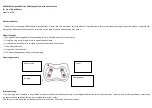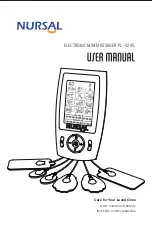
UI HydroFlex. iss4 01/11
UI HydroFlex. iss4 01/11
Seat Too Short;
Increase in pressure
beneath the bottom.
Seat Too Long;
Increased pressure on bottom,
sacrum and shoulders.
1b. Seat Depth
It is important to set seat depth correctly in order to
prevent ‘sacral sitting’ and to achieve the best distribution
of weight between the client and the chair. Sacral sitting
occurs when the pelvis tilts backwards so that the lower
back (sacrum), as well as the bottom, is resting on
the seat cushion. The sacral area can be susceptible to
pressure problems. Sacral sitting will occur if the seat
depth is too long. If the seat depth is too short then
the client’s body weight will be concentrated in too small
an area.
Seat depth should be set with the client’s bottom
positioned
fi
rmly at the back of the seat cushion so
that their lower back and lumbar is supported by the
back cushion. There needs to be a two or three
fi
nger
gap between the client’s calf and the front of the seat
cushion for comfort.
If the client already has a chair or wheelchair with the
correct seat depth, measure this size and use it to set
up the HydroFlex.
Seat depth is adjusted by moving the back of the chair
over the seat unit. The front edge of the seat will stay in
the same place. The seat depth mechanism is controlled
by a release lever on the rear left hand underside of
the seat.
To adjust seat depth, twist the seat depth release lever
clockwise. Hold one of the curved tubes of the seat back
frame and push/pull the back to the desired position.
Once the back is in the correct position let go of the
lever. The back may ‘jump’ back slightly as the locking
mechanism engages.
Release lever for adjusting seat depth.
Seat depth should not be
adjusted when a client is sat in
the chair or when the chair is
tilted backwards.
5
1c. Back Angle Recline
Back Angle Recline (BAR), where hip angle can be
adjusted.
The HydroFlex has Back Angle Recline (BAR). BAR is used
to adjust the angle between the seat and back, thus
changing the angle of the client’s hips.
When the back is fully upright, the angle at the client’s
hips will be approximately 95°. However, because of the
contoured pro
fi
le of the back, the client will
fi
nd this
a comfortable position for mealtimes, activities and for
preparing to raise to standing.
The back angle can be reclined to give a 125° angle at
the hips. This is a comfortable position for resting.
1d. Back Angle Recline
Adjustment
Caution has to be taken when adjusting BAR to provide
a comfortable and stable sitting position. If misused, BAR
can lead to an unstable seating position where the client
can easily slide out of the chair or quickly slide into
sacral sitting. Both sliding actions could lead to pressure
damage through shear.
Ideally, BAR should be altered very occasionally to suit
client condition. For regular changes of position it is best
to use the TiS facility, as this can be adjusted without
affecting pelvic stability. BAR may be disconcerting for
some clients. Please ensure the client is comfortable and
does not become distressed if they are fully reclined
backwards.
1e. Back Angle Recline
Fully Motorised Version
On the motorised HydroFlex BAR is controlled by the
handset. The third row of two buttons control BAR. The
right hand button reclines the back. The left hand button
returns the back to its upright position.
6
Always warn the client before
changing back angle to ensure
they do not become distressed
or agitated.
































